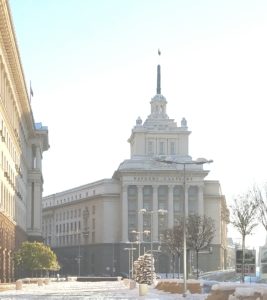Sofia sits in a mountain valley roughly in the center of the Balkan Peninsula. Most of the population live in the city making it feel gigantic. Certainly it has some of everything. There are bigger than life old gray communist buildings. Areas of crumble and poverty. But everywhere signs of rapid recovery from their troubled impoverished past. New shops, storefronts, restored buildings. A new subway system.
In the morning fog the old communist center can look like a gothic dream.
This is an old city. Neolithic settlements are here from 7000BC. But its real history begins as a Thracian settlement from around 1400BC. Later an important Roman city and the home of the Emperor Constantine. The old Roman main street still runs just outside (and probably under) my hotel.
There is a large and vibrant downtown and pedestrian only area, with lots of comparatively well-dressed people enjoying the ambiance, the bars and eateries and their friends. Most of the restaurants in the pedestrian area itself are touristy Italian type places and the street smells like hot pizza cheese and cigarettes. But in the blocks nearby I found plenty of real and interesting restaurants.
Here are some pictures of a few of many fine downtown buildings.
As you go outside the city center there is a large ring of terrible soviet style mid-rise apartment blocks. But then you reach the suburbs where I believe the story of Sofia today is being written. Big shining new office buildings. Shopping centers. This is where the new investment is landing. And it is all automobile centered, right down to the MacDonald drive-through restaurants. And of course many glittering auto showrooms.
Plovdiv
This city had many names over the centuries. It is reckoned by some measure I do not know to be the oldest city in Europe. Anyway, my favorite is Philippopolis: seat of King Phillip, Father of Alexander the Great.
It was founded by the Thracians as a trading post for trade with the Hellenes. Passing to the Celts, Macedonians, Romans, Turks, etc. It was flattened at least twice, and there are ruins everywhere, many just lying around in the open unmarked.
The most comprehensive are those of the Roman city. Even though only a small part of the city has been excavated there are the remains of public buildings, baths, a stadium. And of interest to an old engineer: an ancient water system, and sewers.
Today the old town has been beautifully restored with a large pedestrian only center, making it a pleasure to explore.
The Thracians
This area of the world was the center of the Thracian civilization, some of the earliest of European peoples. The little we know about them we mostly know through the written records of the Greeks. In the Iliad they are described as allies of the Trojans. And the Romans, who conquered them early in the first century.
But the excellent History museum here in Sofia has an exhibition of Thracian artefacts that is very interesting.
Apparently they moved south into this area in the early bronze age around 1500BC. They were often described as barbarians, perhaps because they distained living in cities and had a tribal civilization comprised of numerous small villages. They were noted for their horsemanship (their main god is always depicted on horseback), metalworking, and music.
There are plentiful metal ores in the Balkans, and the Thracians worked copper here, then bronze. Their bronzes cover a broad range of manufacture from weapons and armor to household goods and ornaments.
Their most famous works were in silver and gold.
And wine. These mysterious people living on the edge of prehistory were often referred to as the masters of winemaking. It makes me laugh to think that is perhaps why they are still regarded as the forefathers of the local population .. even though so many other groups and peoples subsequently settled here. The local wine region is called Thracian Valley.
Travel note.
It has been quite a week here weather-wise. I arrived and it was 60 degrees, but within a week it was freezing and snowing. Going to museums was a good strategy.
This entire fall I have been mister “two weeks late” Because everywere I have been I have been told: “Oh, you should have been here two weeks ago when the weather was wonderful”.
On the bus tomorrow down to Greece.






















